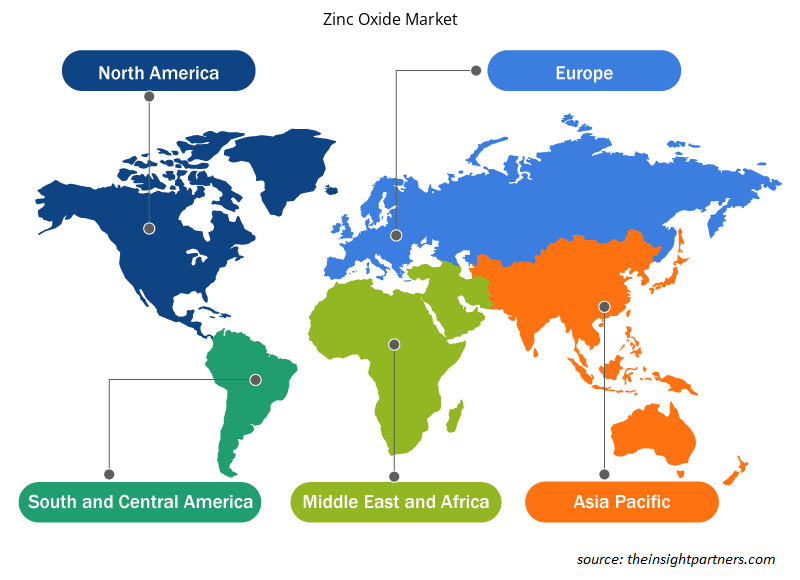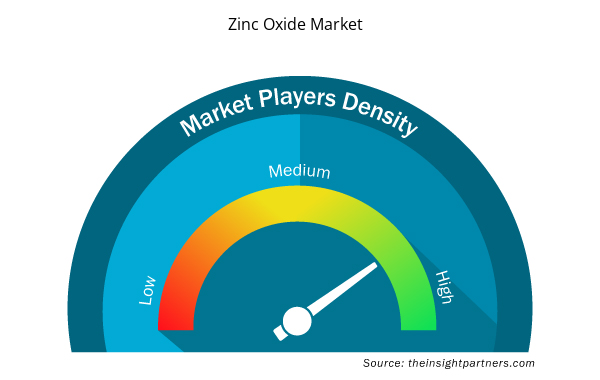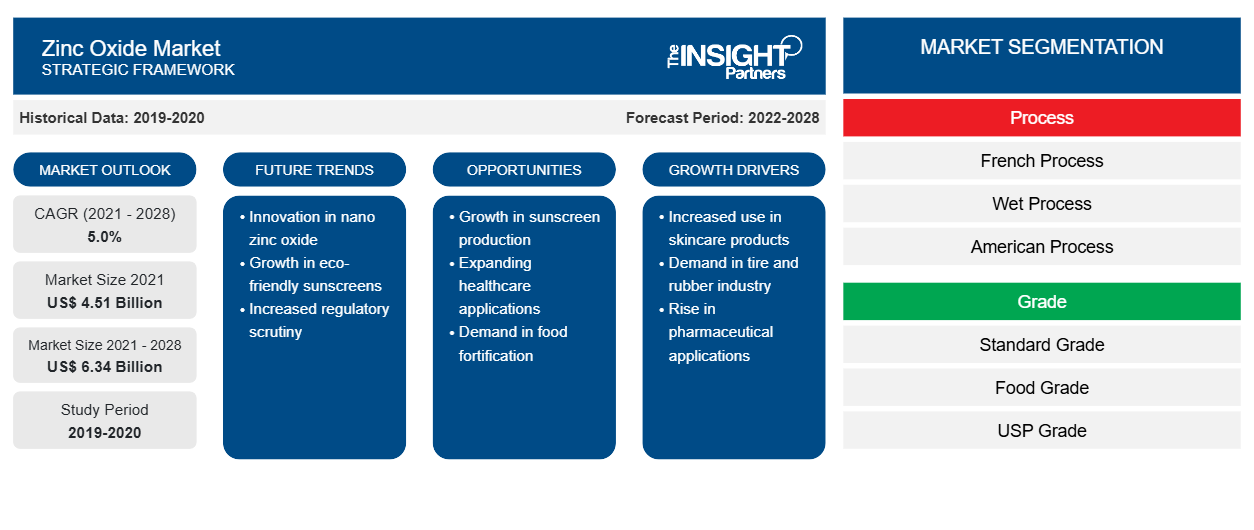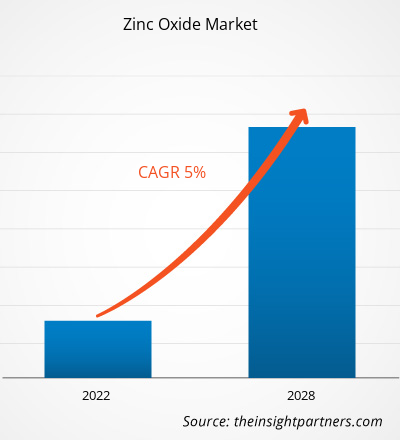Der Markt für Zinkoxid wurde im Jahr 2021 auf 4.506,51 Millionen US-Dollar geschätzt und soll bis 2028 6.338,82 Millionen US-Dollar erreichen; von 2021 bis 2028 wird ein durchschnittliches jährliches Wachstum von 5,0 % erwartet.
Zinkoxid ist eine anorganische Verbindung mit der Formel ZnO . Es ist ein weißes, wasserunlösliches Pulver und wird häufig als Zusatzstoff in zahlreichen Materialien und Produkten verwendet. Außerdem wird ZnO zur Vulkanisierung von Gummi verwendet, um dessen Haltbarkeit zu erhöhen. Die Reifenindustrie verwendet diesen vulkanisierten Gummi außerdem zur Reifenherstellung. Aufgrund der steigenden Reifenproduktion verbraucht die Gummiindustrie mehr als die Hälfte des weltweit produzierten ZnO . Darüber hinaus sind die zunehmende Produktion von Smartgeräten und die Verwendung von Zinkoxid in Kosmetik- und Körperpflegeprodukten, einschließlich Make-up, Babylotionen, Puder und Badeseifen, die wichtigsten Treiber des Zinkoxidmarktes . Es wird auch als Füllstoff, Farbstoff und Hautschutzmittel in rezeptfreien Arzneimitteln wie Sonnenschutzmitteln verwendet.
Darüber hinaus wird Zinkoxid häufig als Zusatzstoff für Schmieröle von Automotoren verwendet, um Oxidationskorrosion und Verschleiß zu reduzieren. Zinkoxide werden zur Herstellung verschiedener Arten von Schmiermitteln verwendet, wie z. B. Hochdruckschmiermittel, fressfeste Schmiermittel und Fette. Daher sind die oben genannten Produkte sehr gefragt und die entsprechenden Branchen verzeichnen ein positives Wachstum. So erzielte die Kosmetikindustrie im Jahr 2021 laut einer Studie von Statista weltweit einen Umsatz von rund 81 Milliarden US-Dollar und verzeichnete ein Wachstum von rund 8 % im Vergleich zum Vorjahr. Ebenso verzeichneten Autoschmierstoffe im Jahr 2021 laut dem Statista- Bericht einen Umsatz von 70,2 Milliarden US-Dollar, was einem Anstieg von rund 5 % im Vergleich zu 2020 entspricht . Das breite Anwendungsspektrum von Zinkoxid erhöht also seinen Verbrauch und treibt in der Folge das Marktwachstum voran.
Passen Sie diesen Bericht Ihren Anforderungen an
Sie erhalten kostenlose Anpassungen an jedem Bericht, einschließlich Teilen dieses Berichts oder einer Analyse auf Länderebene, eines Excel-Datenpakets sowie tolle Angebote und Rabatte für Start-ups und Universitäten.
- Holen Sie sich die wichtigsten Markttrends aus diesem Bericht.Dieses KOSTENLOSE Beispiel umfasst eine Datenanalyse von Markttrends bis hin zu Schätzungen und Prognosen.
Auswirkungen der COVID-19-Pandemie auf den Zinkoxidmarkt
Die COVID-19-Pandemie hat das Wachstum verschiedener Branchen weltweit erheblich gestört. In ähnlicher Weise hatte die COVID-19-Pandemie im Jahr 2020 große Auswirkungen auf den Zinkoxidmarkt, als die Lieferkette des Zinkoxid-Rohstoffs aufgrund der Einschränkung des Warentransports behindert wurde. Lockerungen der Lockdown- Maßnahmen in mehreren Ländern und die wachsende Pharmaindustrie hielten die weltweite Nachfrage nach Zinkoxid aufrecht. Darüber hinaus kurbeln das schnelle COVID-19-Impfprogramm und die zunehmende Verwendung von Zinkoxid für Arzneimittel weltweit das Wachstum des Zinkoxidmarktes an, und die Hersteller von Zinkoxid verzeichnen ein deutliches Wachstum ihres Geschäfts.
Markteinblicke
Wachsende Nachfrage nach grünen Zinkoxid- Nanopartikeln in der Landwirtschaft
Mit der weltweit steigenden Nachfrage nach chemiefreien Lebensmitteln steigt auch der Verbrauch von grünen Zinkoxid- Nanopartikeln , da diese eine sichere Alternative zu herkömmlichen chemischen Methoden darstellen und keine Luftschadstoffe hinterlassen. Zinkoxid- Nanopartikel sind wirksam bei der Keimung und verbessern die Entwicklung von Pflanzen. Sie tragen auch zur Steigerung des Wachstums von Stängeln und Wurzeln bei, ohne dem Boden Nährstoffe zu entziehen. Die Nachfrage nach grünen Zinkoxid- Nanopartikeln steigt aufgrund ihrer bodenbelebenden Eigenschaften und höheren Ernteerträge allmählich an.
Prozesseinblicke
Basierend auf dem Verfahren ist der globale Zinkoxidmarkt in das französische Verfahren, das Nassverfahren, das amerikanische Verfahren und andere unterteilt. Das Segment des französischen Verfahrens war 2020 führend auf dem globalen Zinkoxidmarkt. Das französische Verfahren ist auch als indirektes Verfahren bekannt; bei diesem Verfahren wird Zink in einem Ofen geschmolzen und bei 910 Grad verdampft. Die unmittelbare Reaktion des Zinkdampfs mit Sauerstoff aus der Luft erzeugt Zinkoxid.
Einsichten in die Klasse
Basierend auf der Qualität ist der Zinkoxidmarkt in Standardqualität, Lebensmittelqualität, USP-Qualität und andere unterteilt. Das Segment Standardqualität führte den globalen Zinkoxidmarkt im Jahr 2020 an. Zinkoxid in Standardqualität wird in Laboren, im Forschungs- und Entwicklungssektor häufig als Referenzstandard bei Experimenten verwendet. Zinkoxid in Standardqualität ist hochwertiges und reines Zinkoxid.
Regionale Einblicke in den Zinkoxidmarkt
Die regionalen Trends und Faktoren, die den Zinkoxidmarkt während des Prognosezeitraums beeinflussen, wurden von den Analysten von Insight Partners ausführlich erläutert. In diesem Abschnitt werden auch die Zinkoxidmarktsegmente und die Geografie in Nordamerika, Europa, im asiatisch-pazifischen Raum, im Nahen Osten und Afrika sowie in Süd- und Mittelamerika erörtert.

- Holen Sie sich die regionalspezifischen Daten für den Zinkoxidmarkt
Umfang des Zinkoxid-Marktberichts
| Berichtsattribut | Details |
|---|---|
| Marktgröße im Jahr 2021 | 4,51 Milliarden US-Dollar |
| Marktgröße bis 2028 | 6,34 Milliarden US-Dollar |
| Globale CAGR (2021 - 2028) | 5,0 % |
| Historische Daten | 2019-2020 |
| Prognosezeitraum | 2022–2028 |
| Abgedeckte Segmente | Nach Prozess
|
| Abgedeckte Regionen und Länder | Nordamerika
|
| Marktführer und wichtige Unternehmensprofile |
|
Dichte der Marktteilnehmer für Zinkoxid: Auswirkungen auf die Geschäftsdynamik verstehen
Der Markt für Zinkoxid wächst rasant, angetrieben durch die steigende Nachfrage der Endverbraucher aufgrund von Faktoren wie sich entwickelnden Verbraucherpräferenzen, technologischen Fortschritten und einem größeren Bewusstsein für die Vorteile des Produkts. Mit steigender Nachfrage erweitern Unternehmen ihr Angebot, entwickeln Innovationen, um die Bedürfnisse der Verbraucher zu erfüllen, und nutzen neue Trends, was das Marktwachstum weiter ankurbelt.
Die Marktteilnehmerdichte bezieht sich auf die Verteilung von Firmen oder Unternehmen, die in einem bestimmten Markt oder einer bestimmten Branche tätig sind. Sie gibt an, wie viele Wettbewerber (Marktteilnehmer) in einem bestimmten Marktraum im Verhältnis zu seiner Größe oder seinem gesamten Marktwert präsent sind.
Die wichtigsten auf dem Zinkoxidmarkt tätigen Unternehmen sind:
- EverZinc
- L. Brügge
Haftungsausschluss : Die oben aufgeführten Unternehmen sind nicht in einer bestimmten Reihenfolge aufgeführt.

- Überblick über die wichtigsten Akteure auf dem Zinkoxidmarkt
Anwendungseinblicke
Basierend auf der Anwendung ist der globale Zinkoxidmarkt in Gummi, Landwirtschaft, Chemikalien und Schmierstoffe, Glas und Keramik, Farbe und Pigment, Pharmazeutika und andere unterteilt. Das Gummisegment führte den globalen Zinkoxidmarkt im Jahr 2020 an. Gummi wird häufig zur Herstellung verschiedener Produkte wie Reifen und Schrottschläuchen verwendet; die zunehmende Verwendung von Gummi erhöht die Marktnachfrage nach Zinkoxid. Zinkoxid wird in der Gummiindustrie verwendet, um Verfärbungen zu verhindern und die Wärmestabilität und Produkttransparenz aufrechtzuerhalten.
EverZinc; L. Brüggemann GmbH & Co.; US Zinc; Zochem, Inc.; Umicore; Grillo-Werke AG; Rubamin; JG Chemicals Pvt. Ltd.; Pan-Continental Chemical Co., Ltd.; und Akrochem Corporation sind einige Akteure, die sich aktiv auf die Entwicklung innovativerer Zinkoxide für verschiedene Anwendungen konzentrieren.
Bericht-Spotlights
- Fortschrittliche Markttrends für Zinkoxid helfen den Akteuren bei der Entwicklung wirksamer langfristiger Strategien
- In Industrie- und Entwicklungsländern angewandte Strategien für Unternehmenswachstum
- Quantitative Analyse des Zinkoxidmarktes von 2019 bis 2028
- Schätzung der weltweiten Nachfrage nach Zinkoxid
- Porters Analyse zur Veranschaulichung der Wirksamkeit von Käufern und Lieferanten in der Zinkoxidindustrie
- Aktuelle Entwicklungen zum Verständnis des Wettbewerbsmarktszenarios
- Markttrends und -aussichten sowie Faktoren, die das Wachstum des Zinkoxidmarktes vorantreiben und bremsen
- Unterstützung im Entscheidungsprozess durch Aufzeigen von Marktstrategien, die das kommerzielle Interesse untermauern und zum Marktwachstum führen
- Die Größe des Zinkoxidmarktes an verschiedenen Knotenpunkten
- Detaillierte Übersicht und Segmentierung des Marktes sowie der Dynamik der Zinkoxidindustrie
- Zinkoxid-Marktgröße in verschiedenen Regionen mit vielversprechenden Wachstumschancen
- Historische Analyse (2 Jahre), Basisjahr, Prognose (7 Jahre) mit CAGR
- PEST- und SWOT-Analyse
- Marktgröße Wert/Volumen – Global, Regional, Land
- Branche und Wettbewerbsumfeld
- Excel-Datensatz



Report Coverage
Revenue forecast, Company Analysis, Industry landscape, Growth factors, and Trends

Segment Covered
This text is related
to segments covered.

Regional Scope
North America, Europe, Asia Pacific, Middle East & Africa, South & Central America

Country Scope
This text is related
to country scope.
Häufig gestellte Fragen
Growing demand for butyric acid from animal feed sector is one of the major driving factors for the market. Butyric acid is known for its beneficial effects on gut health and development. For decades, it has been in use in the animal feed industry for ensuring improved gut health and animal performance. The use of butyric acid in animal nutrition also helps in improving nutrient absorption.
Asia Pacific (APAC) is anticipated to grow with the fastest CAGR at rate of 15.3% from 2021 to 2028. The growing number of livestock farms in APAC is propelling animal feed consumption levels, subsequently leading to the proliferation of the butyric acid market.
Due to the COVID-19 pandemic, butyric acid manufacturers witnessed a slight disruption in the supply chain of butyric acid during the first two quarters of 2020. However, the supply chain of butyric acid materials has been restored, and production activities have regained normalcy in late 2020. Later, the market was not significantly negatively impacted by the pandemic. Further, with the growing COVID-19 vaccinations and eased in lockdown restrictions, the global economy is resuming, and subsequently, the butyric acid market is regaining its growth.
Based on application, the animal feed segment accounted the largest share of the global butyric acid market. Butyric acid and fatty acids are extensively used in production of poultry and swine feed due to its beneficial properties such as improving digestibility, better colonisation resistance, and improved growth performance among young livestock.
The major players operating in the global butyric acid market are Eastman Chemical Company; OQ Chemicals GmbH; Tokyo Chemical Industry Co., Ltd.; Perstorp Holding AB; Alfa Aesar; MERCK KGaA; Vigon International, LLC.; Hefei TNJ Chemical Industry Co.,Ltd.; KUNSHAN ODOWELL CO.,LTD; and Yufeng International Co.,Ltd.
During the forecast period, Asia Pacific is anticipated to account for the largest share in the global butyric acid market. The region houses few of the fastest developing economies of the world such as China and India and that are the major consumer of the butyric acid. Moreover, in the Asia Pacific region, there is a growing number of livestock farms which is increasing the consumption of animal feed and subsequently proliferating the butyric acid market.
Trends and growth analysis reports related to Chemicals and Materials : READ MORE..
The List of Companies - Zinc Oxide Market
- EverZinc
- L. Brüggemann GmbH & Co.
- U.S. Zinc.
- Zochem, Inc.
- Umicore
- Grillo-Werke AG
- Rubamin
- JG Chemicals Pvt. Ltd.
- Pan-Continental Chemical Co., Ltd.
- Akrochem Corporation
The Insight Partners performs research in 4 major stages: Data Collection & Secondary Research, Primary Research, Data Analysis and Data Triangulation & Final Review.
- Data Collection and Secondary Research:
As a market research and consulting firm operating from a decade, we have published and advised several client across the globe. First step for any study will start with an assessment of currently available data and insights from existing reports. Further, historical and current market information is collected from Investor Presentations, Annual Reports, SEC Filings, etc., and other information related to company’s performance and market positioning are gathered from Paid Databases (Factiva, Hoovers, and Reuters) and various other publications available in public domain.
Several associations trade associates, technical forums, institutes, societies and organization are accessed to gain technical as well as market related insights through their publications such as research papers, blogs and press releases related to the studies are referred to get cues about the market. Further, white papers, journals, magazines, and other news articles published in last 3 years are scrutinized and analyzed to understand the current market trends.
- Primary Research:
The primarily interview analysis comprise of data obtained from industry participants interview and answers to survey questions gathered by in-house primary team.
For primary research, interviews are conducted with industry experts/CEOs/Marketing Managers/VPs/Subject Matter Experts from both demand and supply side to get a 360-degree view of the market. The primary team conducts several interviews based on the complexity of the markets to understand the various market trends and dynamics which makes research more credible and precise.
A typical research interview fulfils the following functions:
- Provides first-hand information on the market size, market trends, growth trends, competitive landscape, and outlook
- Validates and strengthens in-house secondary research findings
- Develops the analysis team’s expertise and market understanding
Primary research involves email interactions and telephone interviews for each market, category, segment, and sub-segment across geographies. The participants who typically take part in such a process include, but are not limited to:
- Industry participants: VPs, business development managers, market intelligence managers and national sales managers
- Outside experts: Valuation experts, research analysts and key opinion leaders specializing in the electronics and semiconductor industry.
Below is the breakup of our primary respondents by company, designation, and region:

Once we receive the confirmation from primary research sources or primary respondents, we finalize the base year market estimation and forecast the data as per the macroeconomic and microeconomic factors assessed during data collection.
- Data Analysis:
Once data is validated through both secondary as well as primary respondents, we finalize the market estimations by hypothesis formulation and factor analysis at regional and country level.
- Macro-Economic Factor Analysis:
We analyse macroeconomic indicators such the gross domestic product (GDP), increase in the demand for goods and services across industries, technological advancement, regional economic growth, governmental policies, the influence of COVID-19, PEST analysis, and other aspects. This analysis aids in setting benchmarks for various nations/regions and approximating market splits. Additionally, the general trend of the aforementioned components aid in determining the market's development possibilities.
- Country Level Data:
Various factors that are especially aligned to the country are taken into account to determine the market size for a certain area and country, including the presence of vendors, such as headquarters and offices, the country's GDP, demand patterns, and industry growth. To comprehend the market dynamics for the nation, a number of growth variables, inhibitors, application areas, and current market trends are researched. The aforementioned elements aid in determining the country's overall market's growth potential.
- Company Profile:
The “Table of Contents” is formulated by listing and analyzing more than 25 - 30 companies operating in the market ecosystem across geographies. However, we profile only 10 companies as a standard practice in our syndicate reports. These 10 companies comprise leading, emerging, and regional players. Nonetheless, our analysis is not restricted to the 10 listed companies, we also analyze other companies present in the market to develop a holistic view and understand the prevailing trends. The “Company Profiles” section in the report covers key facts, business description, products & services, financial information, SWOT analysis, and key developments. The financial information presented is extracted from the annual reports and official documents of the publicly listed companies. Upon collecting the information for the sections of respective companies, we verify them via various primary sources and then compile the data in respective company profiles. The company level information helps us in deriving the base number as well as in forecasting the market size.
- Developing Base Number:
Aggregation of sales statistics (2020-2022) and macro-economic factor, and other secondary and primary research insights are utilized to arrive at base number and related market shares for 2022. The data gaps are identified in this step and relevant market data is analyzed, collected from paid primary interviews or databases. On finalizing the base year market size, forecasts are developed on the basis of macro-economic, industry and market growth factors and company level analysis.
- Data Triangulation and Final Review:
The market findings and base year market size calculations are validated from supply as well as demand side. Demand side validations are based on macro-economic factor analysis and benchmarks for respective regions and countries. In case of supply side validations, revenues of major companies are estimated (in case not available) based on industry benchmark, approximate number of employees, product portfolio, and primary interviews revenues are gathered. Further revenue from target product/service segment is assessed to avoid overshooting of market statistics. In case of heavy deviations between supply and demand side values, all thes steps are repeated to achieve synchronization.
We follow an iterative model, wherein we share our research findings with Subject Matter Experts (SME’s) and Key Opinion Leaders (KOLs) until consensus view of the market is not formulated – this model negates any drastic deviation in the opinions of experts. Only validated and universally acceptable research findings are quoted in our reports.
We have important check points that we use to validate our research findings – which we call – data triangulation, where we validate the information, we generate from secondary sources with primary interviews and then we re-validate with our internal data bases and Subject matter experts. This comprehensive model enables us to deliver high quality, reliable data in shortest possible time.


 Holen Sie sich ein kostenloses Muster für diesen Bericht
Holen Sie sich ein kostenloses Muster für diesen Bericht